As influencer marketing becomes more popular, almost mainstream, influencer selection becomes even more pivotal to a campaign’s success. Utilizing Influencer Marketing Platforms can aid in identifying genuine influencers who have the ability to influence people, earn their respect, and encourage them to take action.
However, the main prerequisite for a campaign to work is that it uses genuine influencers to spread the brand’s message. There are unscrupulous people online who like the reputation and perks of being considered an influencer, without doing the work needed to reach that status. Moreover, some companies have had their campaigns come unstuck because of these pseudo-influencers.
In short, an influencer has to influence people, have their respect and encourage them to take action. If an “influencer” can’t do that, then they are unworthy of the title.
To help you identify true influencers who can genuinely impact audiences, Influencer Marketing Hub has partnered with HypeAuditor to offer the Instagram Follower Growth Analyzer. This tool enables you to analyze follower growth and engagement, ensuring you connect with influencers who bring real value to your campaigns.
Join the Planet’s largest community of Creators & Influencers
Registration includes
- Free usage of over 40 Influencer Tools
- Access to Complimentary Premium Online Courses
- Unlimited Articles and Resources
Already A Member? Sign In
Most People Suffer From Fake Instagram Followers
The days are long gone since you could say, “It must be true – I read it on the internet.” You cannot just assume that if somebody claims they large numbers of followers on Instagram, that these people take any interest in the person’s account – or indeed that these followers are real people at all.
Unscrupulous people boost their follower numbers by buying Instagram followers. Sometimes these are real people, happy to earn extra cash. Other times these are fake accounts set up by bots. No matter how they are created, the fake followers will not engage with the “influencer’s” posts in any way and are of no value to a brand wanting to work with him or her.
Instagram (or indeed the other social networks) cannot eliminate all fake accounts. Determined scammers will always find a way around any security mechanisms Instagram can put in place. So it is up to brands (and indeed genuine influencers) to hunt out and find fake followers.
It is important to remember that it is not just people wanting to inflate their follower lists who have fake followers. Virtually everybody on Instagram has some. This includes genuine influencers (and probably your own account).
What Are The Negative Impacts of Fake Followers On Instagram?
Reduced Engagement
Having a high follower count might look impressive, but fake followers can drastically reduce engagement rates. These followers don't interact with your content, leading to fewer likes, comments, and shares.
As a result, your posts may not reach a wider audience, affecting your visibility on Instagram's algorithm. Lower engagement can also hurt your credibility with potential partners and sponsors, who rely on genuine interaction metrics to evaluate influence.
Damaged Reputation
Fake followers can significantly damage your reputation on Instagram. A sudden spike in followers, coupled with low engagement, can raise suspicions among Instagram users.
When brands and followers discover that your audience is inflated with bots or inactive accounts, they may question your authenticity and integrity. This skepticism can lead to a loss of trust and credibility, making it difficult to secure collaborations or partnerships.
Violation of Platform Policies
Using fake followers violates Instagram's platform policies, putting your account at risk of penalties. Instagram actively monitors and removes accounts that use unethical practices to boost their follower count.
Violations can lead to shadowbanning, where your content becomes less visible, or even account suspension.
Why People Buy Followers
Some people mistakenly think that the most important factor for social media success is the number of followers somebody has. So, they try to take a shortcut to their success and pay to buy followers. They equate the number of followers you display with your level of popularity.
However, that is not how social media works. Anybody can buy followers. But, you will not be an influencer unless you can influence people. You need to become a thought leader in your niche, and organically build your following.
The problem with buying followers is that it gives you a very unbalanced account. You have thousands of followers, but little engagement. The only person you influence is yourself, and it is not that hard for anyone analyzing your account to spot what you have done.
Signs of a Fake Follower
But what makes a fake follower? How can you say somebody isn’t a genuine follower? Here are some of the danger signs to look for in an Instagram account.

1. An account has “unusual” numbers
Genuine accounts tend to have similar patterns when it comes to numbers of followers, people followed, and levels of engagement. Although everybody operates their accounts differently, and some “newbies” don’t run their accounts like seasoned Instagrammers, you can still easily spot outliers.
For instance, they may like and follow thousands of people, but don’t have many following them in return. Perhaps they don’t make many if any, posts themselves. This doesn’t necessarily mean that they are a bot, but it does suggest that will be of little value as a follower. They definitely don’t influence anybody.
Genuine influencers will have more followers than accounts they follow – often by a substantial margin.
For instance, we recently looked at the Top 10 Instagram fitness models.
Sommer Ray tops that list. She has 23.8 million followers, but only follows 904 accounts in return.
Even the 10th person on our list, Izabel Goulart, has a one-sided ratio: 4.4 million followers to 660 accounts followed.
An ordinary Instagrammer may have a rate closer to 1:1, but nobody (apart from perhaps a complete “newbie”) should have substantially more accounts followed than followers.
Similarly, you should look at a potential influencer’s engagement rate. A quality influencer will have engagement (likes and comments) of about 1.5-3% of their followers, e.g., if an influencer has 100,000 followers, you should see 1,500 – 3,000 likes and comments (combined) on an average post. An engagement rate of 1 percent is okay for many influencers, depending on their niche. If an “influencer’s” engagement rate for his/her posts is regularly well below than this, you should be suspicious, however.
Don’t think higher is necessarily better, however. An engagement rate of 10 percent plus could be suspicious. If you see engagement rates that high, the influencer could be using artificial engagement techniques, such as being part of an engagement group (influencers work together, commenting and liking each other’s posts to boost their statistics).
2. A lot of action for a few days, but then little other activity
Often somebody will create a bot that follows hundreds or thousands of people on the day of its creation. It may even share some content on that day to make it look genuine. Once the bot has followed sufficient people, it stops and relies on people not checking their accounts and unfollowing the fake account.
Additionally, fake followers often exhibit irregular patterns of engagement, such as liking multiple posts within a short period or leaving generic comments. These unusual engagement patterns further highlight the inauthentic nature of such accounts.
Genuine influencers tend to have relatively steady growth in their follower numbers. The rate of increase may grow once they are recognized as an influencer, but they will not have a massive burst of followers in a short period of time (as most fake accounts do).
3. Empty, Hidden or Copied Profile Sections
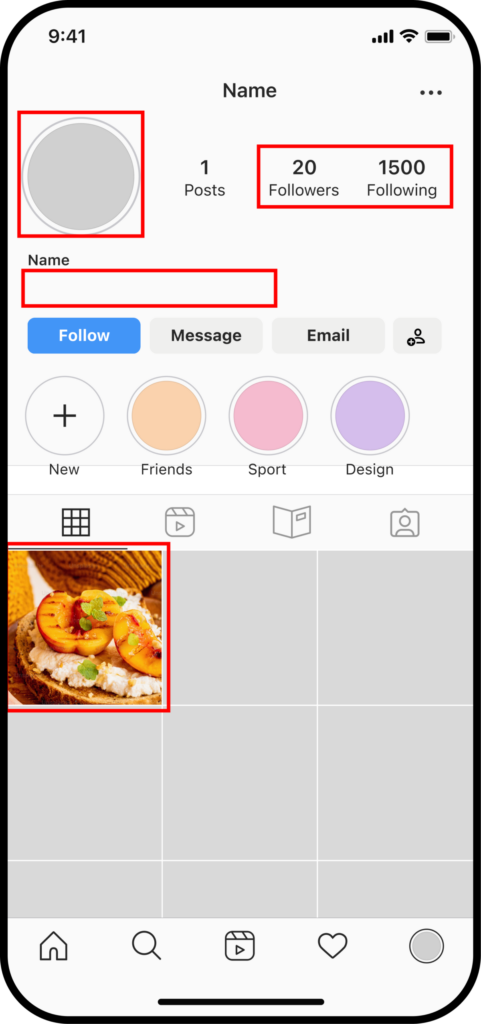
Empty Instagram account example
People creating fake accounts usually don’t put much effort into creating realistic-sounding bios. Sometimes they just leave the bio section blank, or they just fill in the minimum details. They sometimes even adjust the settings to make the profile hidden. This makes your investigation harder, as you can't see their details. You should ask yourself, however, how genuine is somebody who hides their bio details. Are they likely to make an engaging, dedicated follower?
Similarly, you should consider a lack of a profile picture to be a red flag, particularly in a visual medium like Instagram.
In some cases, unscrupulous Instagrammers “catfish” you by creating totally fake bios, often using somebody else’s picture. These are frequently just images picked up from stock photo sites.
4. Spammy, Irrelevant and Clueless Comments
Some of the smarter bot accounts (and even some of the more dishonest human-operated accounts) create comments to make them appear genuine. The problem is that these comments are generic and lack substance. For instance, you might spot that an account continually comments “good picture” or “good job.”
While these comments are technically engagement, they have no value to a brand that is hoping for an influencer to persuade his / her followers that the brand’s product will be suitable for them.
Likewise, some accounts leave irrelevant spam comments, obviously trying to sell something. Sometimes these are poorly thought through and executed sales tactics. In other cases they are more sinister, encouraging you to leave contact information, so they steal your identity.
You can also try our Instagram Money Calculator out to see what your posts are worth.
Instagram Influencer Earnings Calculator
Engagement Rate
0.13%
Estimated Earnings Per Post
$20,000 - $30,000
How To Get Rid Of Fake Instagram Followers With Third-Party Tools
Several online tools and applications can assist you in discovering fake Instagram followers. These tools analyze your followers' activities and provide insights regarding their authenticity.
Instagram Audit Tools
Instagram audit tools are essential for identifying and removing fake followers from your account. These tools evaluate your follower base and determine the percentage of suspicious or fake accounts. By analyzing follower activity, engagement patterns, and profile characteristics, audit tools can pinpoint accounts that may be detrimental to your credibility.
One such tool is HypeAuditor's Instagram Audit, which provides a comprehensive analysis of your followers.
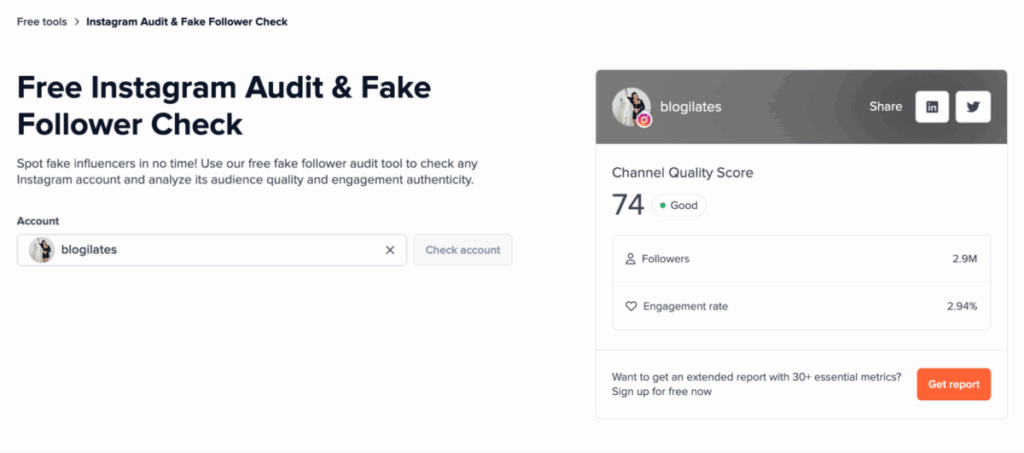
HypeAuditor fake follower check example
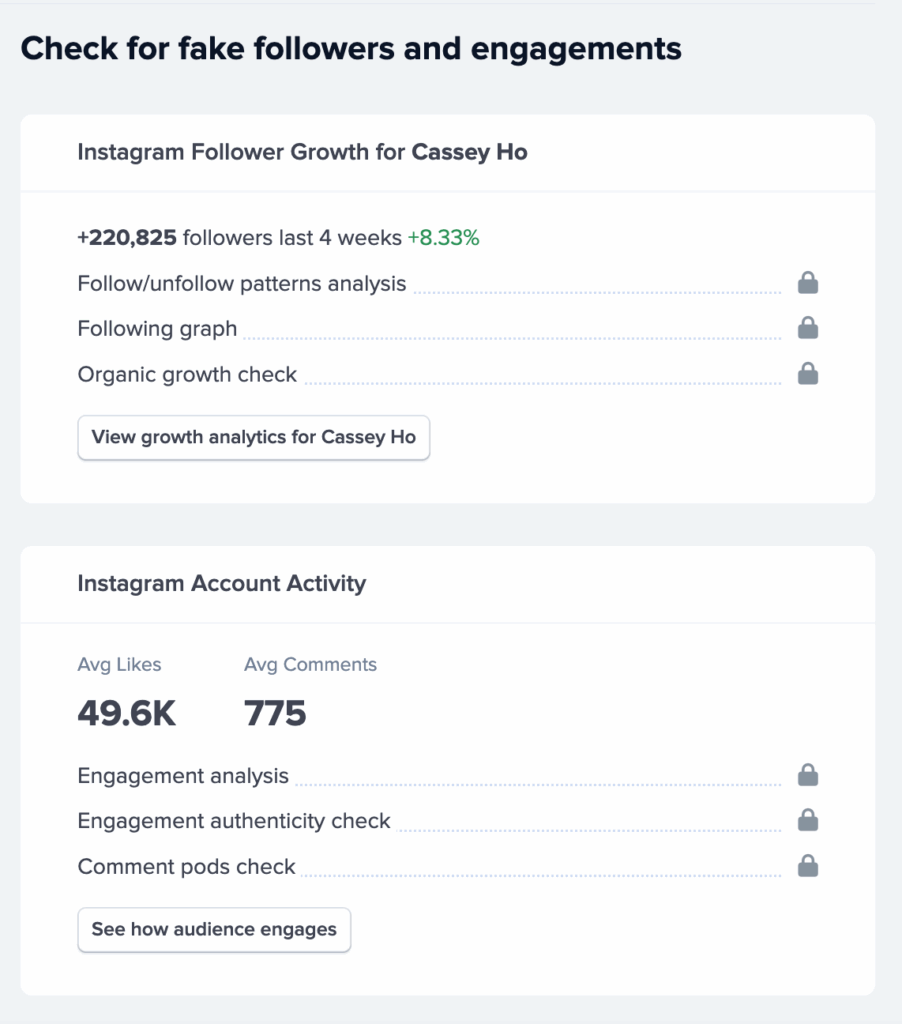
HypeAuditor check for fake followers and engagements
Using HypeAuditor, you can gain valuable insights into the authenticity of your audience, helping you take action to remove fake followers. Regular audits help maintain the integrity of your account, improving your overall engagement rate and boosting your reputation with potential collaborators and sponsors.
Engagement Analytics
Instagram engagement analytics are vital for spotting fake followers. By analyzing engagement patterns, you can identify accounts with abnormally high or low engagement rates, often indicative of fake followers. These analytics help you understand the true interaction level of your audience, highlighting discrepancies that may harm your account's credibility.
One useful tool for this purpose is SocialBlade, which offers free Instagram analytics. SocialBlade allows you to monitor follower growth and engagement metrics, making it easier to detect suspicious activity.
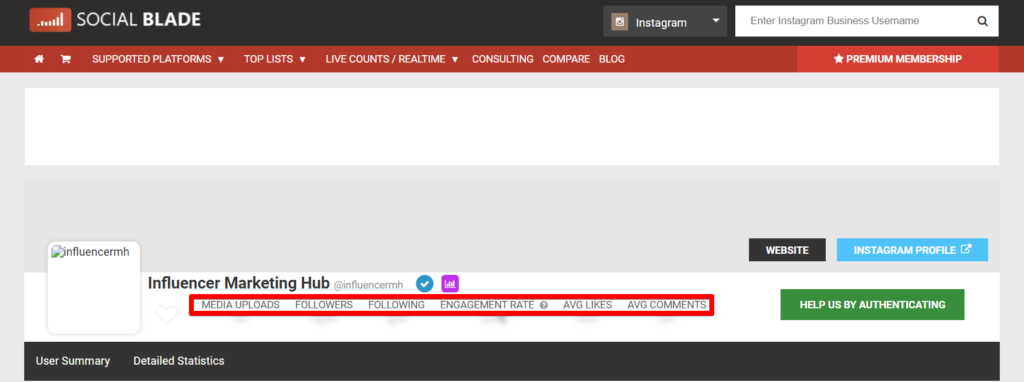
Social Blade Instagram analytics example
You can compare a user’s current engagement rate with the average, but for more in-depth Instagram analytics you’ll need to use a paid tool.
Fake Follower Checkers
Fake follower checkers are essential tools for maintaining the authenticity of your Instagram account. These tools analyze your follower base to identify and remove fake accounts, which can harm your engagement rates and credibility. By using these checkers, you can ensure that your audience is genuine and engaged, thereby enhancing your reputation and appeal to potential collaborators.
One popular tool is the HypeAuditor Fake Follower Checker, which provides detailed insights into the authenticity of your followers. This tool evaluates engagement rates, follower growth patterns, and other metrics to detect suspicious activity.
Another valuable resource is the UpGrow Instagram Audit Tool, which offers a comprehensive analysis of your follower base. This tool helps identify fake or inactive accounts by evaluating follower activity and engagement metrics.
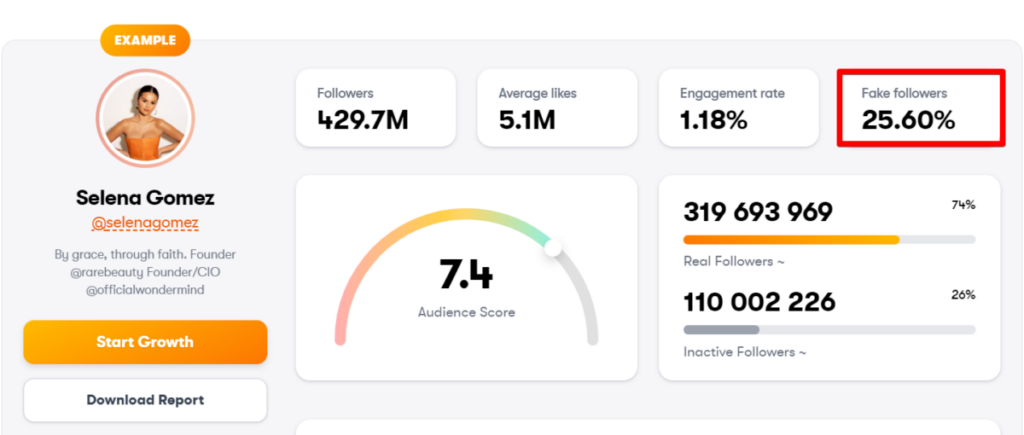
Upgrow fake followers checker
Finally, Upfluence’s Instagram Fake Follower Checker is another powerful resource for detecting inauthentic followers. It analyzes engagement patterns and the quality of your followers to help maintain an authentic audience.
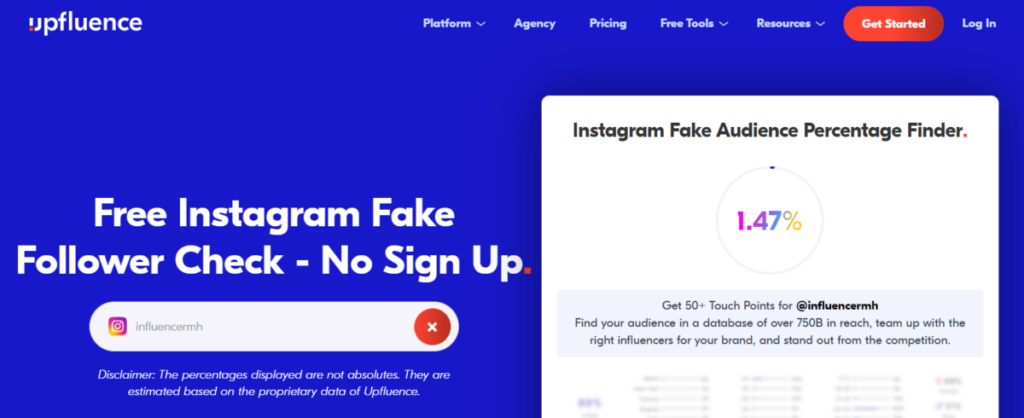
Upfluence fake follower checker
Frequently Asked Questions
How can you tell if Instagram followers are fake?
If your account scores poorly in our Instagram Audit Tool, you probably have a high proportion of fake followers. You need to look at your followers and delete any that look suspicious. You should identify any followers with:
- An account with "unusual" numbers
- A lot of action for a few days, but then little other activity
- Empty, Hidden or Copied Profile Sections
- Spammy, Irrelevant and Clueless Comments
Why do fake Instagram accounts follow me?
There is, unfortunately, a large business of buying and selling fake Instagram followers. Why do people do it? They do it to boost their engagement numbers. Some people want to increase their own follower numbers to make their accounts look more important and active than they really are. They deliberately pay for fake people and bots to follow them. For this to work, however, the fake accounts need to look genuine. So they follow legitimate accounts in the hope that these people follow them back.
Is Instagram cleaning fake followers?
Buying fake followers is very much against Instagram's terms and conditions. Therefore, they are always on the look-out for such practices. Instagram regularly removes accounts it suspects of leaving spam comments and following / unfollowing thousands of unrelated accounts. Instagram has stated that people who use fake follower services may also be punished. Instagram says it may limit access to certain features for such accounts. Therefore, if you notice that your follower numbers have dropped, it may be because some were fake, and Instagram removed them.
Should you buy Instagram followers?
You should never buy Instagram followers. Most of these accounts will either be bots, fake accounts, or disinterested people who have let their accounts be used in return for payment. None of these accounts will look at your posts or participate in any genuine engagement. Over time most of these accounts will disappear from your Followers list, either because they have unfollowed you or because Instagram will have spotted them and removed them from the platform.





